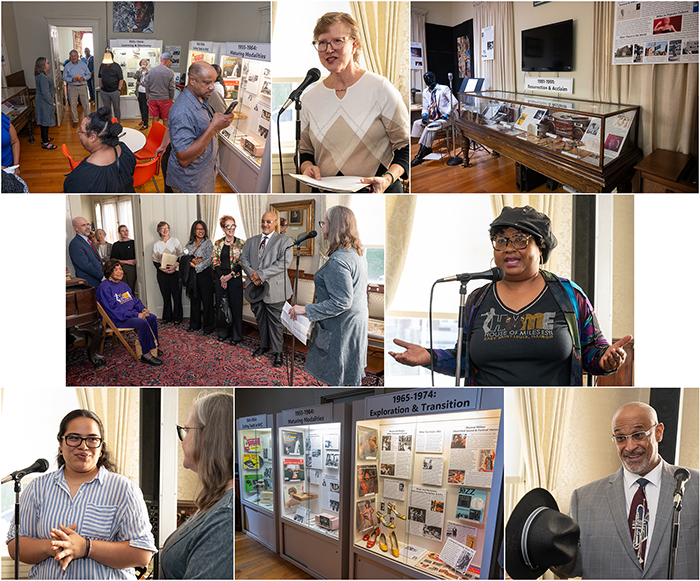SIUE Collaboration on Miles Davis Exhibit Hits High Note

In the final week of Southern Illinois University Edwardsville’s public programming in collaboration with the Smithsonian Community Curation 2024: St. Louis event series, attendees were treated to an SIUE community engagement project, the “Miles Davis: Modes and Modalities, 1935-1990” exhibit at the St. Clair County Historical Society (STCCHS).
“The aim of this exhibit is to explore Miles’ life and work in light of the influences of local roots and significant people, as well as through the changing cultural and technological contexts of the five decades of Miles’ professional life,” said lead curator, SIUE Professor Emeritus Cory Willmott, PhD, who initiated the exhibit and was the project manager. “The project actually started two years ago with researching clothing for characters in Miles’ life – an unusual springboard for a musician, but Miles was an unusual kind of guy. We also encompass Miles’ visual expressive art, such as fashion, acting and drawing.”
Items on display were from the collections of the St. Clair County Historical Society, Belleville Historical Society, House of Miles, Lovejoy Library and private donors to create the cultural milieu that surrounded Miles Davis during different periods of his life.
“We ended up contributing 12 items: nine album covers, two music compact discs and one cassette tape, and they ranged in years of vintage recordings from 1959 to 1990,” said Therese Dickman, Lovejoy Library’s associate professor and Fine Arts Librarian. “I'm thrilled to say that five of those items came from our National Ragtime Jazz Archive collections.”
SIUE Professor Emeritus Prince Wells III is a trumpeter experienced in Lydian Chromatic Concept having studied with Davis's good friend George Russell who conceived the method. Wells shared that Davis and Russell explored "a different way to relate to chords” after Davis played bebop with Dizzy Gillespie.
“He told George Russell that he really wanted to learn all the chords,” said Wells. “And George said, ‘Well, everybody thought Miles Davis already knew all the chords.’ And George, in thinking about that, came up with this Lydian Chromatic Concept.”
“He and Miles talked about this a lot, and that's when Miles changed his approach to jazz completely to the more modal jazz. Miles started writing songs that are much more subtle-- maybe just a couple of chords in a whole song--which gave you more time to be more lyrical, more thoughtful, more expressive, and that's where he really made his contribution,” said Wells.
As members of the curatorial team, the Historical Society’s William P. Shannon, IV, and fourth-year SIUE anthropology student and intern, Tilomai Tauiliili, also contributed vital ideas, exhibit components and production labor. Tauiliili’s hands-on curatorial experience and the opportunity to network with local and national museum professionals was a great opportunity for student professional development, a vital part of community engagement.
“Miles was so unique and prolific that we can’t possibly be comprehensive. Instead, we’ve tried to paint the broad strokes of Miles’ life story through three themes (Muses and Modes, Musical Milieu, and Music and Musicians), while also focusing on mini-stories of impactful episodes, technologies and people,” said Willmott.
Lauren Parks, President and Co-Founder House of Miles, shared news that planning has already begun to move the exhibit to House of Miles for the Miles Davis centennial birthday celebration in 2026.
“Miles Davis: Modes and Modalities, 1935-1990” will be open to the public at the St. Clair County Historical Society at 701 E Washington St., Belleville, through September of 2025 on Fridays, 10-3 pm, or by appointment by calling (618) 234-0600, emailing Will Shannon IV ([email protected]), or by consulting the STCCHS website.
Photos by Howard Ash









